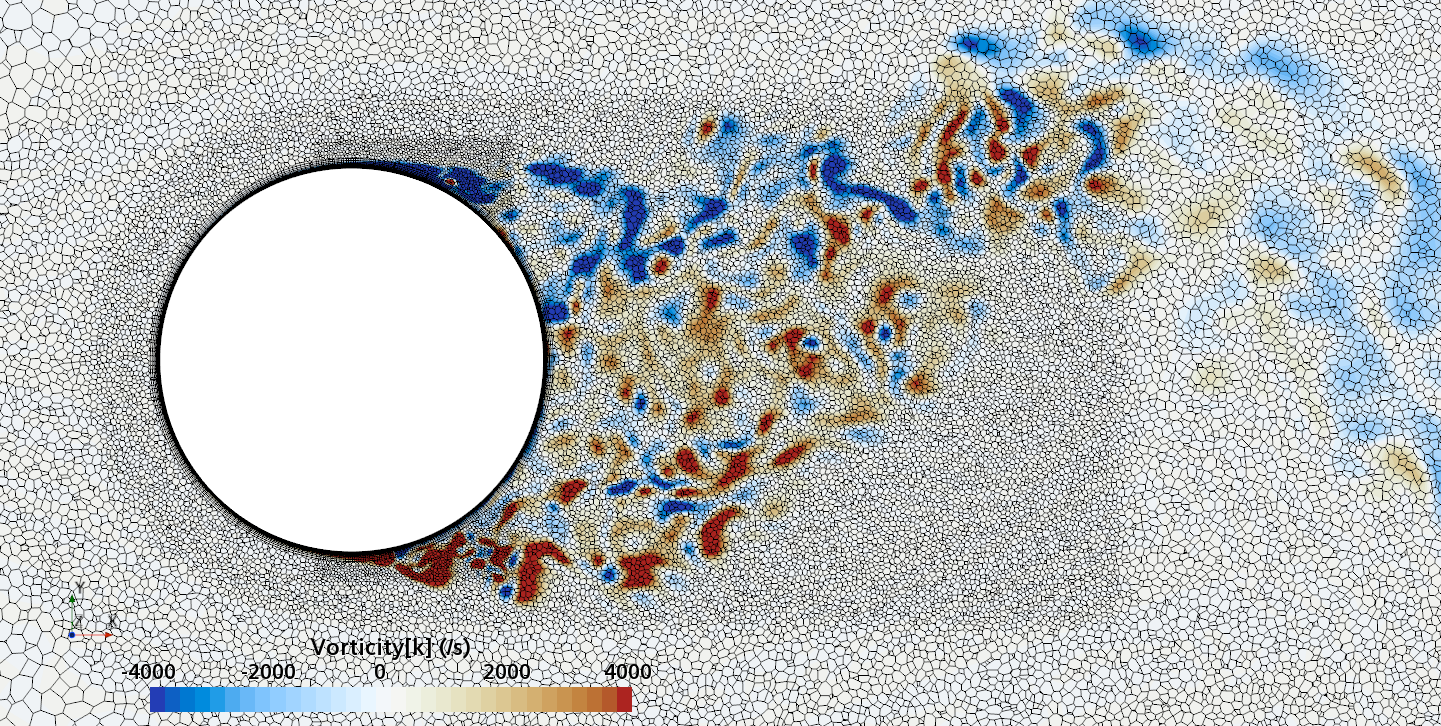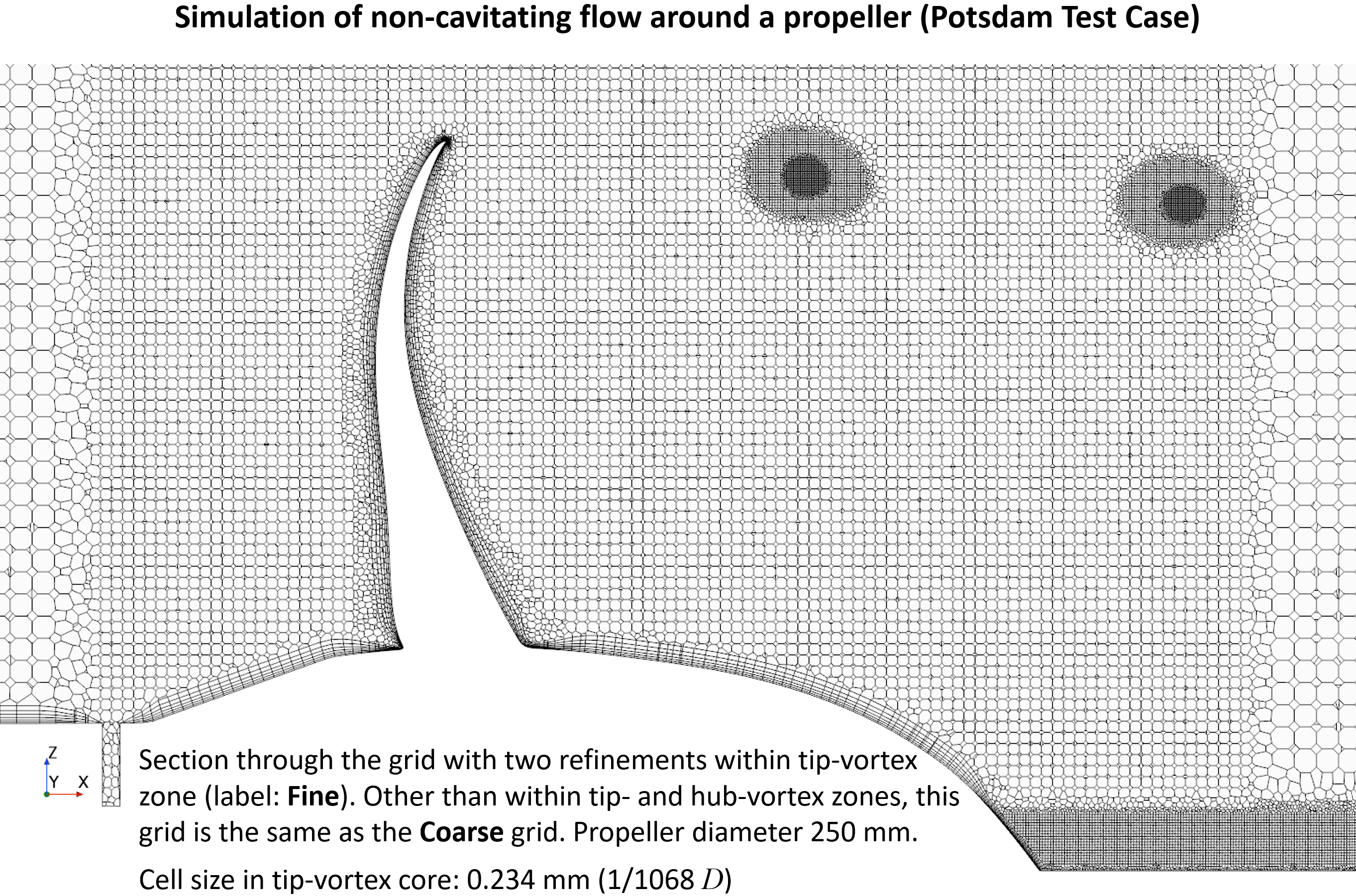Gallery
Here some pretty pictures and animations from flow simulations with a brief explanation are shown:


Instantaneous pattern of laminar flow around circular cylinder in an infinite environment at Re = 500: fixed cylinder (upper) and rotating cylinder (lower).

Instantaneous pattern of turbulent flow around circular cylinder in an infinite environment at Re = 5,000 (DNS).


Instantaneous pattern of turbulent flow around circular cylinder in an infinite environment at Re = 50,000 (LES): Section through the grid with vorticity contours (upper) and animation of vorticity variation (lower).

Instantaneous pattern of turbulent flow around circular cylinder in an infinite environment at Re = 500,000 (LES): animation of vorticity variation.


Instantaneous pattern of turbulent flow around a sphere held by a rear stick at Re = 50,000 (LES): animation of vorticity variation for a smooth sphere (upper) and a sphere with a trip wire (lower). Trip wire introduces local laminar flow separation with turbulent reattachment; the downstream turbulent boundary layer separates much later than in the case of a smooth sphere, leading to a 3 times lower drag!




Instantaneous pattern of turbulent flow around a sphere held by a rear stick at Re = 50,000 (LES): animation of vorticity variation for a smooth sphere in cross-section at 1/4 of diameter, 1/2 diameter, 1 diameter and 1.5 diameter downstream of sphere center, respectively, from top to bottom. The top two animations show a higher intensity of turbulence at the outer edge of the separation zone (highest shear) and lower intensity within separation zone. One diameter downstream of sphere center the whole wake is strongly turbulent but still relatively centered around the stick, while 1.5 diameters downstream of sphere center the wake is meandering around the stick and some zones are only intermittently turbulent.



Instantaneous pattern of turbulent flow around a sphere held by a rear stick at Re = 50,000 (LES): animation of vorticity variation for a sphere with a trip wire in cross-section at 1/4 of diameter, 1/2 diameter, and 1 diameter downstream of sphere center, respectively, from top to bottom. The top two animations show a higher intensity of turbulence at the outer edge of the separation zone (highest shear) and lower intensity within separation zone. One diameter downstream of sphere center the whole wake is strongly turbulent and already beginning to meander around the stick (the flow separation zone is much shorter than for the smooth sphere). See Section 10.3.4.2 in the book for more details.



Free-surface flow around a container ship (model scale, fixed): wave pattern (upper) and comparison of predicted and measured wave profiles along two lines parallel to hull (middle and lower). See Section 13.10.1 for examples of flow around floating bodies.



Simulation of flow around a propeller in a uniform flow (open-water test), with pronounced tip vortexes: local grid refinement within tip-vortex zone (top) and pressure (middle) and velocity (bottom) profiles across tip vortex. Both velocity and pressure very extremely rapidly across tip vortex, which requires extremely fine grid to accurately predict extrema in velocity and pressure profiles, which is essential in order to accurately predict tip-vortex cavitation (see Section 13.8 in the book).

Instantaneous pattern of a turbulent, buoyancy-driven flow in the symmetry plane of a cubic cavity at a high Rayleigh-number (left) and the corresponding temperature field (right). White arrows indicate flow direction along isothermal vertical walls. Note stable stratification with nearly horizontal isotherms in the central part of the cavity.

Instantaneous pattern of a turbulent, buoyancy-driven flow in the symmetry plane of a cubic cavity at a moderate Rayleigh-number (left) and the corresponding temperature field (right). This is the case of unstable stratification (hot wall at the bottom, cold wall at the top). Black arrows indicate the flow direction in the section plane. Note that the flow is three-dimensional; fluid flows also in the direction normal to the section plane.



























